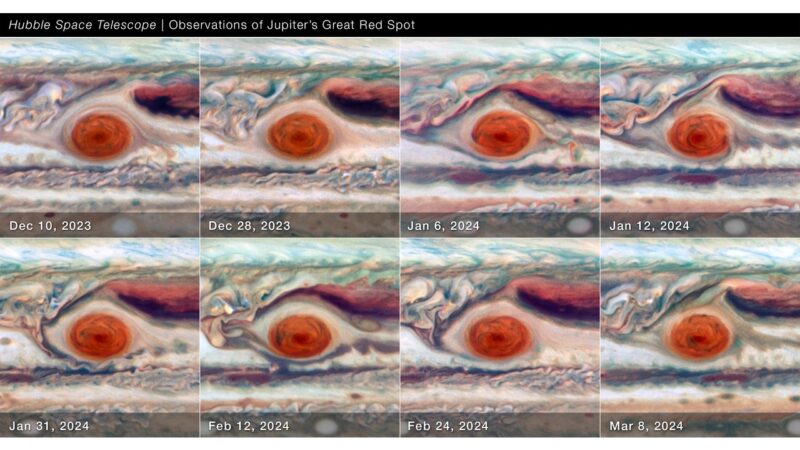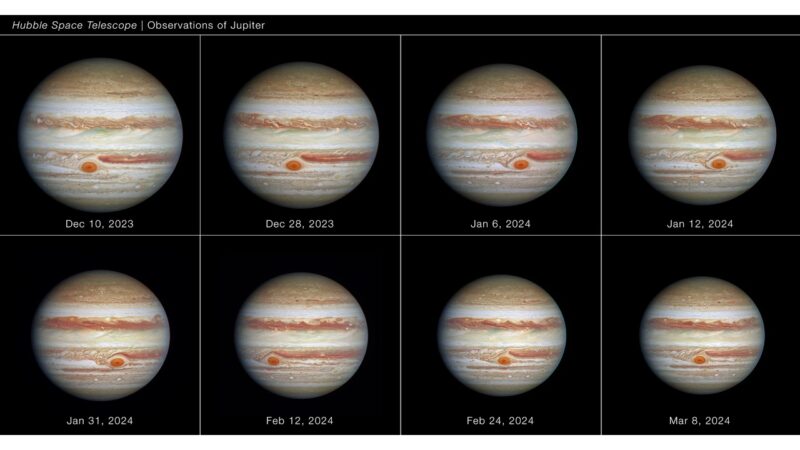- Jupiter’s Great Red Spot wiggles like gelatin. That’s according to scientists using observations from the Hubble Space Telescope.
- The giant anticyclone has been around for at least 150 years, but it’s not as stable as it looks.
- It’s the first time scientists have seen the spot oscillate. The jet streams keep it in place but the storm gets squeezed like a stress ball.
NASA published this original story on October 9, 2024. Edits by EarthSky.
Jupiter’s Great Red Spot wiggles like gelatin
Astronomers have observed Jupiter’s legendary Great Red Spot, an anticyclone large enough to swallow Earth, for at least 150 years. But Hubble’s new observations of the famous red storm reveal the Great Red Spot is not as stable as it might look. Recent data collected for 90 days from December 2023 to March 2024 show the Great Red Spot jiggles like a bowl of gelatin. The combined Hubble images allowed astronomers to assemble a time-lapse movie of the squiggly behavior of the Great Red Spot.
Amy Simon of NASA’s Goddard Space Flight Center in Greenbelt, Maryland, is the lead author of the science paper published in the peer-reviewed The Planetary Science Journal. Simon said:
While we knew its motion varies slightly in its longitude, we didn’t expect to see the size oscillate as well. As far as we know, it’s not been identified before. This is really the first time we’ve had the proper imaging cadence of the Great Red Spot. With Hubble’s high resolution we can say that the Great Red Spot is definitively squeezing in and out at the same time as it moves faster and slower. That was very unexpected, and at present there are no hydrodynamic explanations.
Watch Jupiter's Great Red Spot as it oscillates over time. Images from the Hubble Space Telescope between Dec 2023 and Mar 2024. pic.twitter.com/RZEzy1t8zf
— Kelly Kizer Whitt (@Astronomommy) October 10, 2024
Storms on other worlds
Hubble monitors Jupiter and the other outer solar system planets every year through the Outer Planet Atmospheres Legacy program (OPAL) led by Simon. But these observations were from a program dedicated to the Great Red Spot. Understanding the mechanisms of the largest storms in the solar system puts the theory of hurricanes on Earth into a broader cosmic context. This knowledge might be applied to better understanding the meteorology on planets around other stars.
Simon’s team used Hubble to zoom in on the Great Red Spot for a detailed look at its size, shape, and any subtle color changes. Simon said:
When we look closely, we see a lot of things are changing from day to day.
This includes ultraviolet-light observations showing that the distinct core of the storm gets brightest when the Great Red Spot is at its largest size in its oscillation cycle. This indicates less haze absorption in the upper atmosphere.

The Great Red Spot is trapped between jet streams
Co-investigator Mike Wong of the University of California at Berkeley said:
As it accelerates and decelerates, the Great Red Spot is pushing against the windy jet streams to the north and south of it. It’s similar to a sandwich where the slices of bread are forced to bulge out when there’s too much filling in the middle.
Wong contrasted this to Neptune, where dark spots can drift wildly in latitude without strong jet streams to hold them in place. Jupiter’s Great Red Spot has been held at a southern latitude, trapped between the jet streams, for the extent of Earth-bound telescopic observations.

A shrinking storm?
The team has continued watching the Great Red Spot shrink since the OPAL program began 10 years ago. They predict it will keep shrinking before taking on a stable, less-elongated, shape. Simon said:
Right now it’s over-filling its latitude band relative to the wind field. Once it shrinks inside that band the winds will really be holding it in place.
The team predicts the Great Red Spot will probably stabilize in size, but for now Hubble only observed it for one oscillation cycle.
The researchers hope that in the future other high-resolution images from Hubble might identify other Jovian parameters that indicate the underlying cause of the oscillation.
The scientists presented their results at the 56th annual meeting of the American Astronomical Society Division for Planetary Sciences, in Boise, Idaho.
Bottom line: New observations with the Hubble Space Telescope show that Jupiter’s Great Red Spot wiggles like a bowl of gelatin. It squeezes in and out like a stress ball.
Source: A Detailed Study of Jupiter’s Great Red Spot over a 90-day Oscillation Cycle
Read more: Jupiter’s Great Red Spot is 190 years old, scientists say











